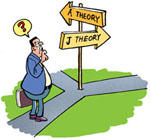Theory is a set of interrelated variables, definitions and propositions that presents a systematic view of phenomena by specifying relationships among variables with the purpose of explaining natural phenomena (Hussey and Hussey, 1997). It is a combination of principles, a model and initial assumptions. It is often meet as an adversary in scientific work. A theoretical model, is an imagined mechanism  or process, postulated by analogy with familiar mechanisms or processes and used to construct a theory to correlate a set of observations. It is the source of the analogy ‘the familiar system’ where ‘familiar’ means better understood rather than everyday. The model drawn from the familiar system suggests a theory. It also suggests possible relationships between some of the terms of the theory and some observation terms; these correlations linking theory and observation are called ‘rules of correspondence’. A theoretical model is used to generate a theory to explain the behaviour of an observable system. A theory, believed to be correct, may after a long time, be falsified or improved. A theory can only describe a natural phenomenon which does not necessarily follow from experimental observations (Benson, 1991) however it may have different kinds of origin.
or process, postulated by analogy with familiar mechanisms or processes and used to construct a theory to correlate a set of observations. It is the source of the analogy ‘the familiar system’ where ‘familiar’ means better understood rather than everyday. The model drawn from the familiar system suggests a theory. It also suggests possible relationships between some of the terms of the theory and some observation terms; these correlations linking theory and observation are called ‘rules of correspondence’. A theoretical model is used to generate a theory to explain the behaviour of an observable system. A theory, believed to be correct, may after a long time, be falsified or improved. A theory can only describe a natural phenomenon which does not necessarily follow from experimental observations (Benson, 1991) however it may have different kinds of origin.
 or process, postulated by analogy with familiar mechanisms or processes and used to construct a theory to correlate a set of observations. It is the source of the analogy ‘the familiar system’ where ‘familiar’ means better understood rather than everyday. The model drawn from the familiar system suggests a theory. It also suggests possible relationships between some of the terms of the theory and some observation terms; these correlations linking theory and observation are called ‘rules of correspondence’. A theoretical model is used to generate a theory to explain the behaviour of an observable system. A theory, believed to be correct, may after a long time, be falsified or improved. A theory can only describe a natural phenomenon which does not necessarily follow from experimental observations (Benson, 1991) however it may have different kinds of origin.
or process, postulated by analogy with familiar mechanisms or processes and used to construct a theory to correlate a set of observations. It is the source of the analogy ‘the familiar system’ where ‘familiar’ means better understood rather than everyday. The model drawn from the familiar system suggests a theory. It also suggests possible relationships between some of the terms of the theory and some observation terms; these correlations linking theory and observation are called ‘rules of correspondence’. A theoretical model is used to generate a theory to explain the behaviour of an observable system. A theory, believed to be correct, may after a long time, be falsified or improved. A theory can only describe a natural phenomenon which does not necessarily follow from experimental observations (Benson, 1991) however it may have different kinds of origin. 
No comments:
Post a Comment